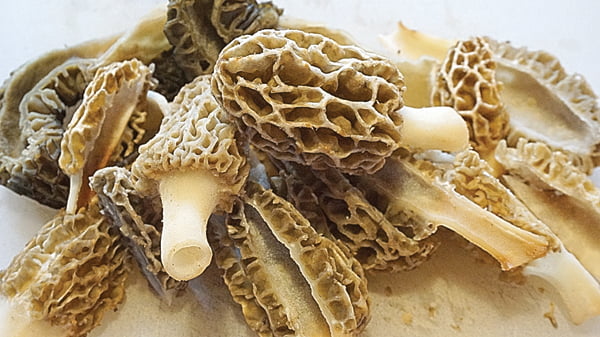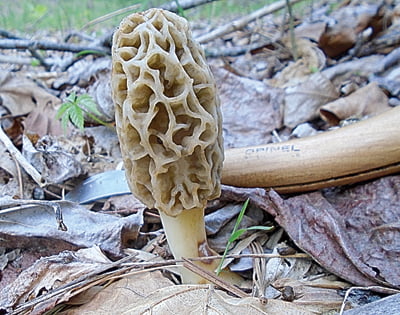

Ken Springer
Watoga Park Foundation
The ‘morel’ of the story
Morchella esculenta, Morchella elata, Morchella semilibera, Morchella augusticeps, are otherwise known as “morels” by those who love them and spare no effort at finding them. For the millions of people who live within its vast world-wide range, the morel needs no introduction.
It is not that people are merely fond of morels, they are howl-at-the-moon crazy about them, and with good reason. The flavor of this fungus is incomparable to any other edible. It’s often described as woodsy and nutty, but mere words do not describe the taste of the morel, the flavor is ineffable. Most people are hooked at the first bite, setting off a lifetime love affair with this strange looking mushroom.
There are those very rare individuals who do not appreciate the exquisite flavor of the morel, but it is generally assumed that these few people have suffered physical damage to their taste buds at some point in their lives. Perhaps by sticking their tongues on a frozen flagpole one sub-zero winter day. But again, these folks are relatively rare and tend to believe that the Earth is flat and that unicorns romp about in the old growth area at Watoga.
Ambrosia is a term that is often used when speaking of the morel, and those who consistently find them refer to their favorite spots as “honey holes” – these special locations are closely guarded secrets. They may reveal their favorite ramp patch to their brother-in-law, or that wooded ridge where they always find clusters of Chicken of the Woods to a close relative, but the location of their morel honey holes go to the grave with them.
I once had a great morel honey hole, and I only made the mistake of revealing its location once and that was to my ex-wife – when we were still married, of course. After that, she always beat me to the spot every spring, leaving index cards hanging from tree branches saying things like, “Thanks, Big Mouth” and “That will teach you to keep your mouth shut,” and “You knew I couldn’t be trusted when morels are concerned.”
Not only did my ex have a penchant for morels but she was fiercely competitive, greedily jumping in front of me if she saw me stooping over to pick a morel, grabbing it and putting it in her basket. After a few years of fungal abuse, I divorced her, and my honey holes have been top secret ever since.
Wealthy Russians attending the annual Oligarch/ KGB Banquet in Moscow have been seen ignoring Beluga Caviar* to get their hands on a simple plate of fried morels. And though they are reluctant to admit it, the truffle hunting pigs that the French take such pride in are totally distracted from digging up the revered subterranean Perigord Truffle** by the faint scent of a single morel.***
If I told you that the word “morel” can be used in the same sentence with deathbed confessions, bribery and drive-by poaching you may not believe me, but read on.
My 87-year-old father was on his deathbed at his home in Florida in 2007. One by one, my siblings and I stood by his bed and talked to him privately before he passed on. During my turn, I asked him if there was anything left undone in his life, or anything he would like to do one more time. I thought for sure that he would lament that he never made it back to Australia where he had spent a month of R&R during World War II and always talked about it fondly, on occasion muttering something about “Those delightful Aussie gals.”
Instead, he drew me nearer to his face and said in a weakening voice, “Those morels you over-nighted to me last April to share with the family – I ate them all.” He went on to say that if he could have anything in the world it would be one more plate of morels fried in butter. Well, there cannot possibly be a more honest statement than one made at the very end of one’s life, and it also says volumes about his passion for the morel.
My friends, Jim and Beth Bullard, tell a wonderful story of being out early one spring morning on Thorny Creek Road here in Pocahontas County. They were birding when a 60-ish man in a white pickup truck stopped beside them and inquired, “Are you m’rellin?” He said it fast and they were not quite sure what he said so they asked him to repeat his question. Again he said, “Are you m’rellin?” Evidently seeing the quizzical looks on Jim and Beth’s faces he finally said, “Are you hunting for morels?”
They told him that they were birding and at that he headed on down the road in his truck. He returned a short while later and showed them a bag of big white morels. He then explained that he was “m’rellin” from his truck and went on to tell them that he did his “m’rellin” at 20 miles per hour, but adding proudly that he had an uncle that was able to do his “m’rellin” at 40 miles per hour. The Bullards have never forgotten that incident on Thorny Creek Road, and their eyes twinkle with humor each time they recount that story.
Finally, the value placed on morels has even made it onto a TV series. The Dutch series on Amazon, called Lord and Master, has an episode where the protagonist attempts to bribe a bad guy who is about to kill him by offering a kilo and a half of morels. His life was spared.
Oh, the power of the morel.
Happy hiking and m’rellin,
Ken Springer
* Beluga Caviar $3,200 to $4,500/ lb.
** Perigord Truffle $96 to $168/oz.
*** Morels – Free, if you can find them.


